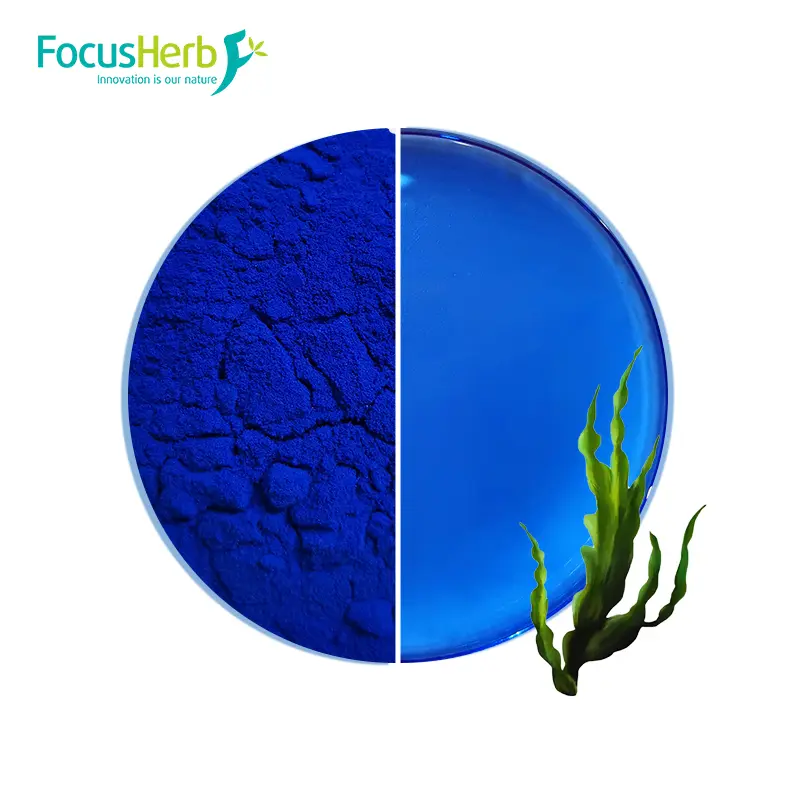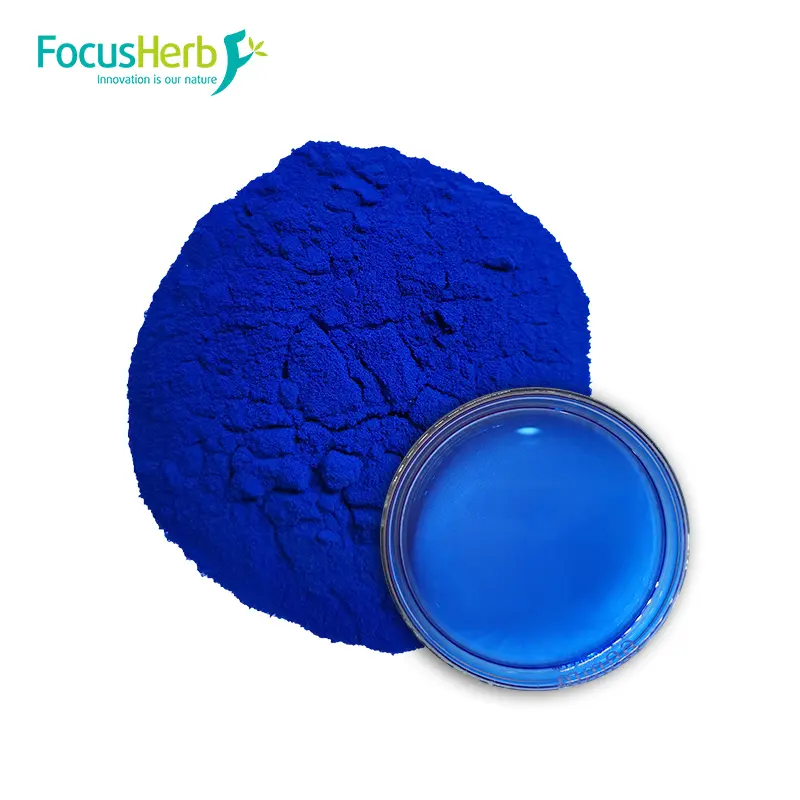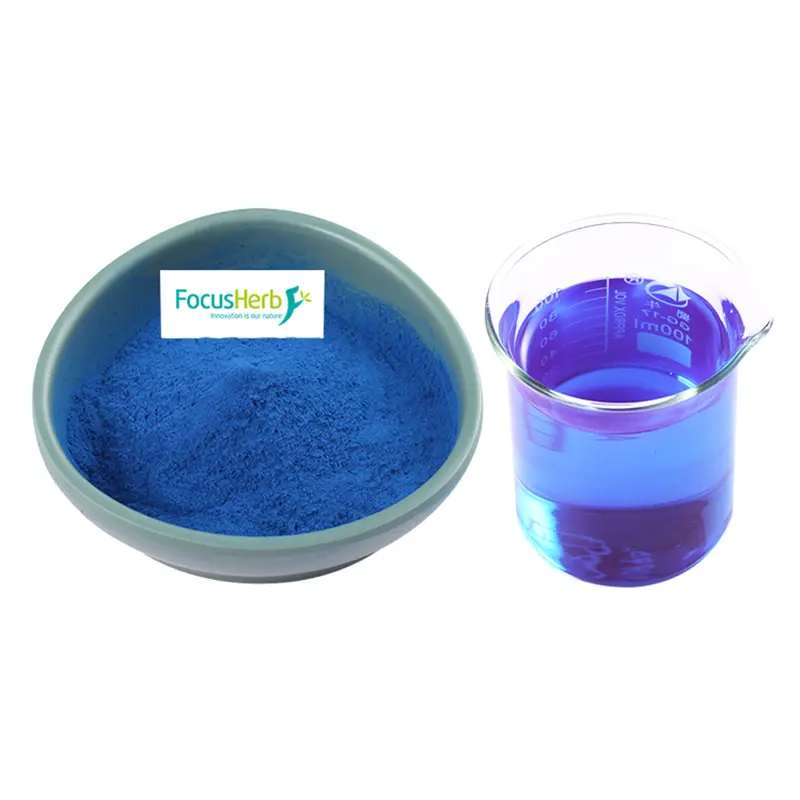Phycocyanin, a unique natural blue pigment, is gradually emerging as a vibrant and vibrant color in the fields of food, cosmetics, and biomedicine. Like a dazzling pearl hidden within marine algae, it exudes a captivating blue glow, not only adding a touch of vibrant color to products but also playing an indispensable role in numerous industries due to its unique properties. Phycocyanin typically appears as a fine, uniform, deep blue powder. When dissolved in water, it quickly transforms clear liquids into a deep, pure blue. This blue, like the mysterious starlight blue of the deep night sky or the undisturbed blue waters of the ocean’s depths, is profound and captivating, instantly captivating the eye.
 The Benefits of Phycocyanin Revealed
The Benefits of Phycocyanin Revealed
Natural and Healthy
With people increasingly focused on health, the “clean label” movement is gaining momentum in industries like food and cosmetics. As a natural pigment, phycocyanin offers unparalleled advantages over synthetic pigments. Synthetic pigments are often produced through chemical synthesis, such as using aniline dyes isolated from coal tar. Erythrosine, a dye newly banned by the US FDA in January 2025, is derived from petroleum refining. While low-cost and boasting strong coloring power, its safety has been questioned. Studies have shown that high doses of Red 3 can induce thyroid cancer in rats. Phycocyanin, on the other hand, is extracted from natural algae such as cyanobacteria. The extraction process is relatively environmentally friendly. For example, Zhejiang Binmei Biotechnology Co., Ltd.’s innovative “low-temperature targeted cell wall disruption” technology uses water as an extraction medium, achieving precise cell wall disruption and efficient isolation of phycocyanin, avoiding the damage to its structure and activity caused by high temperatures and chemical reagents. This natural source makes phycocyanin safer. It contains no harmful chemicals and has no toxic side effects, meeting consumers’ demand for natural and healthy products. Consequently, it has become a top choice for many consumers seeking high-quality, healthy lifestyles.
Outstanding Physiological Activity
Powerful Antioxidant Capacity: In the complex “microcosm” of the human body, free radicals are like uncontrolled “troublemakers,” constantly generating and attacking cells, causing cell damage, accelerated aging, and even a range of diseases. Phycocyanin, like a valiant “guardian,” with its unique molecular structure, is an effective weapon for neutralizing these free radicals. Numerous studies have demonstrated that phycocyanin can effectively scavenge superoxide anions, hydrogen peroxide, and hydroxyl radicals from the body. Experimental data show that, in specific experimental systems, phycocyanin can achieve a superoxide anion scavenging rate of over 80% and a hydroxyl radical scavenging rate of approximately 60%. Its antioxidant activity is not only far superior to that of common antioxidants such as SOD and vitamin C, but it can also further enhance the body’s antioxidant defenses by regulating the levels of antioxidant enzymes such as superoxide dismutase (SOD) and glutathione peroxidase (GSH-Px). This multi-pathway antioxidant mechanism enables phycocyanin to demonstrate remarkable effectiveness in protecting cells, delaying aging, and preventing disease, providing a solid defense for our health.
Immune Modulation: In the fast-paced modern world, immunity has become our first line of defense against disease. Phycocyanin, with its remarkable immunomodulatory properties, is a powerful aid in strengthening the body’s immune system. It stimulates immune system activity, promoting the proliferation and differentiation of macrophages, T cells, and B cells, thereby enhancing the body’s ability to recognize and eliminate pathogens. Related studies have found that feeding experimental animals a diet containing phycocyanin significantly enhanced the phagocytic activity of their macrophages, increased the number of T and B cells, and improved the secretion of immune factors. For people with compromised immune systems, such as the frail, the elderly, and those recovering from surgery, phycocyanin supplementation can help boost immunity and reduce the risk of infection. In anti-tumor support, phycocyanin enhances NK cell and T cell activity, helping to inhibit tumor cell growth and mitigate the damage to the immune system caused by chemotherapy and radiotherapy. In inflammatory diseases, such as autoimmune diseases (e.g., rheumatoid arthritis) or chronic inflammation, phycocyanin regulates the balance of immune factors and alleviates excessive inflammatory responses.
Potential other benefits: In addition to its antioxidant and immunomodulatory properties, phycocyanin has demonstrated potential in other areas. In anti-cancer research, multiple experiments have shown that it can inhibit the growth and spread of various cancer cells, including lung, liver, and colon cancer. Phycocyanin inhibits DNA synthesis and cell division, arresting cancer cells in the G0/G1 phase, thereby preventing further proliferation. It can also induce apoptosis, reducing tumor size. In one experiment with lung cancer cells, the addition of phycocyanin significantly inhibited cancer cell proliferation and significantly increased the apoptosis rate. While research on blood sugar regulation is still in its early stages, studies have shown that phycocyanin may regulate blood sugar levels by modulating insulin secretion or increasing insulin sensitivity. Regarding cardiovascular health, phycocyanin can effectively lower blood cholesterol levels, particularly low-density lipoprotein (LDL), the “bad” cholesterol, while increasing high-density lipoprotein (HDL), the “good” cholesterol. This helps prevent the development of atherosclerosis and further protects the cardiovascular system from damage through anti-inflammatory and anti-platelet aggregation mechanisms.
Unique Application Value
Applications in the Food Industry: Phycocyanin is a versatile food additive, serving as both an excellent colorant and a nutritional enhancer. In the beverage industry, many juice drinks and sparkling waters are now incorporating phycocyanin, giving them a distinctive blue hue that distinguishes them from the crowd. For example, some juice brands that promote natural and healthy beverages not only attract consumers with the color, but also enhance their health benefits through its nutritional content. In candy, for example, Mars’ M&Ms, after Europe designated phycocyanin as a coloring food in 2013, blue M&Ms returned to the European market, satisfying consumers’ love for blue candy. In baked goods, the addition of phycocyanin to bread and cakes not only enhances their appearance but also their nutritional value. Statistics show that the market share of foods incorporating phycocyanin has been growing at an annual rate of 15% in recent years, demonstrating increasing consumer acceptance of these products.
Expansion into other sectors: In cosmetics, phycocyanin, thanks to its antioxidant and anti-inflammatory properties, has become an ideal skincare ingredient. Many high-end skincare products incorporate phycocyanin to help protect the skin from environmental damage and maintain its youthful appearance. It can reduce signs of aging, such as wrinkles and hyperpigmentation, and soothe sensitive skin, reducing inflammation and redness. In the pharmaceutical field, phycocyanin can be used as a raw material for antioxidants, anticancer drugs, and liver-protecting medications, contributing significantly to human health. Several phycocyanin-based drugs are currently undergoing clinical trials. In biological testing, phycocyanin can also be used as a bioluminescent probe to label biomolecules, helping researchers better understand physiological processes within organisms and providing a powerful tool for life science research.
Important Disadvantages
Stability Challenges
Sensitivity to light and heat: Despite its numerous advantages, phycocyanin suffers from poor stability and is sensitive to light and heat. Under illumination, the conjugated double bonds in its molecular structure interact with light, triggering a series of complex photochemical reactions that lead to structural changes. When phycocyanin is exposed to strong sunlight, its color gradually fades within just a few hours, from its original deep blue to a pale blue, or even to nearly colorless. This is because the energy of light destroys its chromophores, altering their light absorption capacity and affecting their color. Phycocyanin’s stability also faces significant challenges in high-temperature environments. As temperatures rise, molecular thermal motion intensifies, disrupting the protein’s tertiary and quaternary structures and causing it to lose its original spatial conformation. Research has shown that when temperatures exceed 60°C, phycocyanin‘s structure begins to undergo significant structural changes. After 30 minutes at 80°C, its activity can decrease by more than 50%, and its color can become significantly lighter. This limits its application in products that require high-temperature processing or long-term storage in sunlight. For example, during high-temperature baking, phycocyanin loses its color due to the heat, preventing it from providing a stable color.
Significantly affected by pH: Phycocyanin exhibits significant stability differences under different pH conditions. In an acidic environment, hydrogen ions in the solution react with certain groups within the phycocyanin molecule, such as amino groups, disrupting the protein’s charge distribution and hydrogen-bonding network, leading to structural changes. When the pH falls below 4.5, phycocyanin may precipitate and its color shifts from blue to yellow-green. This structural change affects its light absorption and scattering properties. In alkaline environments, hydroxide ions also damage the phycocyanin structure. When the pH rises above 9.0, the chromophores of phycocyanin are affected, causing the color to fade and ultimately losing its value as a pigment. This high sensitivity to pH requires strict control of the pH of the environment used for phycocyanin, limiting its use in products with unstable acidic and alkaline environments, such as acidic beverages or alkaline detergents, where phycocyanin struggles to maintain a stable color.
Research Status and Future Outlook
Research Progress and Breakthroughs
Innovations in Extraction and Purification Technologies: In recent years, significant innovations have been made in the extraction and purification of phycocyanin. Traditional extraction methods have numerous drawbacks, such as the time-consuming and energy-intensive bead milling method, the tendency for ultrasonication to denature proteins, and the cumbersome and difficult-to-scale freeze-thaw method. However, new technologies have emerged, bringing new hope to phycocyanin extraction. Among them, “low-temperature targeted cell wall disruption” technology is an innovative breakthrough. Zhejiang Binmei Biotechnology Co., Ltd. successfully developed this technology after thousands of experiments and refinements. Using water as the extraction medium and utilizing specific physical methods, this technology precisely disrupts algal cells, achieving efficient isolation of phycocyanin. Compared to traditional methods, it offers numerous advantages. In terms of extraction efficiency, this method can increase phycocyanin extraction by 20%-30%, significantly increasing production. Furthermore, due to reduced energy consumption and equipment wear, costs are reduced by 15%-20%. Furthermore, the low temperature prevents high-temperature damage to the phycocyanin structure, preserving its natural activity and nutritional value to a great extent, allowing the extracted phycocyanin to better exert its physiological functions in subsequent applications.
Stability Enhancement Research Results: Researchers have conducted extensive research to address the poor stability of phycocyanin and have achieved a series of results. Microencapsulation technology is one of the effective methods for improving phycocyanin stability. By encapsulating phycocyanin in tiny capsules, a protective layer is formed, effectively isolating it from the effects of external environmental factors. Lü Xiaoling et al. used gelatin and maltodextrin as wall materials and prepared phycocyanin microcapsules using an air suspension coating method. Experiments showed that microcapsules prepared at 80°C, an atomization pressure of 0.15 MPa, and a core-to-wall ratio of 1:1.5 (20% gelatin in the wall material) exhibited significantly improved photostability, thermal stability, and storage stability. Under light exposure, the color retention of the microencapsulated phycocyanin exceeded 80%, while that of the unencapsulated phycocyanin was only 30%-40%. Under high temperature, the activity loss of the microencapsulated phycocyanin was significantly lower than that of the untreated phycocyanin. Chemical modification techniques have also provided a new approach to improving phycocyanin stability. Chemical modification of phycocyanin molecules alters their structure and properties, thereby enhancing their stability. The researchers used specific chemical reagents to react with certain groups within the phycocyanin molecule, forming stable chemical bonds and significantly enhancing the stability of phycocyanin under various environmental conditions. Chemically modified phycocyanin maintains good structural and color stability under varying pH conditions, with minimal color change within the pH range of 3-10, while unmodified phycocyanin exhibits significant color changes under acidic or alkaline conditions. These technological advances have laid a solid foundation for the widespread application of phycocyanin in a wider range of fields, offering broad application prospects.
Future Application Trends
New Directions in the Food Industry: With the increasing pursuit of health and personalized nutrition, the application of phycocyanin in the food industry will explore new directions. Phycocyanin is expected to become a key component in the field of new health foods. In the future, more functional snacks rich in phycocyanin may emerge, such as phycocyanin energy bars. These bars are not only rich in high-quality plant protein, but also possess phycocyanin’s unique antioxidant and immunomodulatory properties, meeting consumers’ needs for both energy and health. Phycocyanin yogurt, by adding phycocyanin to traditional yogurt, not only offers the nutritional benefits and taste of yogurt, but also provides consumers with additional health benefits such as enhanced immunity and improved intestinal microbiome. Phycocyanin will also play a significant role in personalized nutritional foods. Develop customized foods based on the nutritional needs and health conditions of different populations. For the elderly, develop nutritional supplements rich in phycocyanin to boost immunity and slow aging. For sports enthusiasts, develop sports drinks containing phycocyanin to replenish water and electrolytes while rapidly repairing muscle damage and improving athletic performance.
Cross-disciplinary potential: Phycocyanin has enormous potential applications in healthcare. In drug development, it could become a key raw material for new antioxidant, anti-inflammatory, and anti-cancer drugs. Current studies have shown that phycocyanin can inhibit the growth and spread of various cancer cells. Future development into anti-cancer drugs could provide new options for cancer treatment. In the health supplement sector, phycocyanin can be formulated into various nutritional supplements, such as capsules, tablets, and oral liquids, to meet diverse consumer needs and help boost immunity, improve sleep quality, and regulate blood lipids. In the environmental field, phycocyanin can be used for biomonitoring. Due to its exceptional sensitivity to certain pollutants, it can be used as a bioindicator. By measuring changes in phycocyanin activity and content, it can be used to monitor pollution in water and soil, providing a scientific basis for environmental protection. In the agricultural field, phycocyanin can be used as an additive in biofertilizers to provide nutrition to plants and promote plant growth; it can also be used as a plant growth regulator to regulate plant physiological processes, improve plant resistance, reduce the use of pesticides, and achieve the development of green agriculture.
A Rational Approach to Phycocyanin Pigments
Phycocyanin, a unique natural pigment, exhibits numerous advantages in food, cosmetics, and pharmaceuticals. Its natural and healthy properties, excellent physiological activity, and unique application value have made it a new favorite in numerous industries. However, we cannot ignore its shortcomings. Poor stability and high extraction costs have, to a certain extent, limited its large-scale application and development.
Thankfully, researchers have made significant progress in extraction and purification technologies, as well as in enhancing its stability, laying a solid foundation for its further application. Future application trends suggest that phycocyanin will develop in the food industry towards new health foods and personalized nutritional foods. It also holds tremendous potential for expansion in cross-sectors such as healthcare, environmental protection, and agriculture.
We should approach phycocyanin pigments rationally, fully leveraging its advantages to bring greater benefits to human health and well-being, while also actively addressing and working to address its existing challenges. Through continuous technological innovation and research breakthroughs, we believe that phycocyanin will occupy an even more important position in the natural pigment field, injecting new vitality into the development of related industries and presenting a broad application prospect in the future.










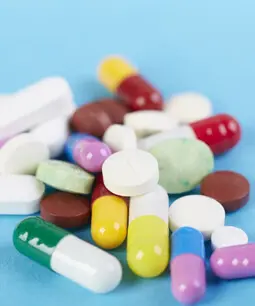








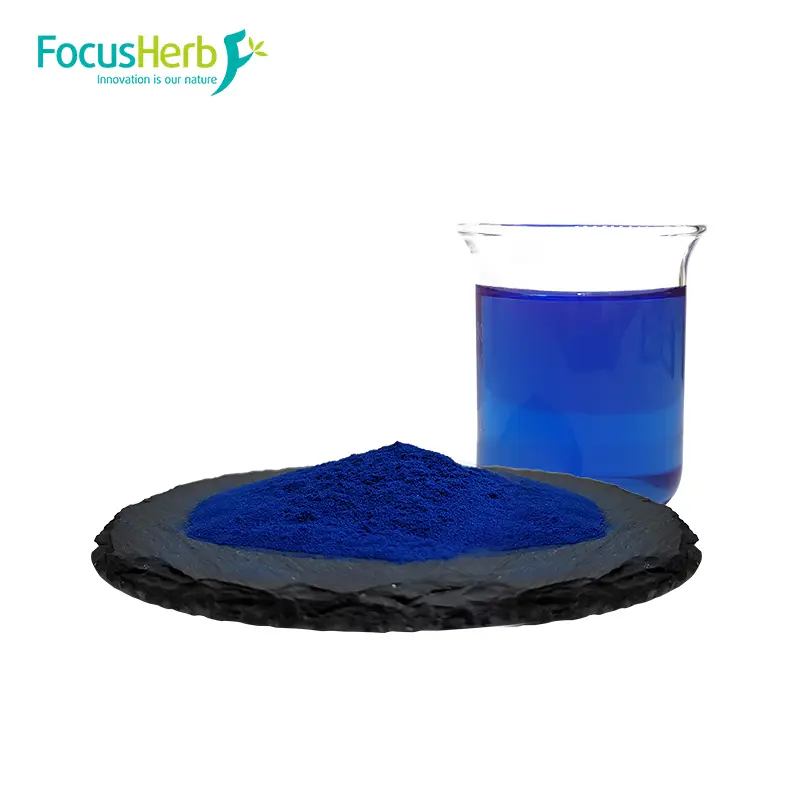 The Benefits of Phycocyanin Revealed
The Benefits of Phycocyanin Revealed